

Zitierweise / cite as:
Payer, Alois <1944 - >: Dharmashastra : Einführung und Überblick. -- 9. Erbrecht. -- Anhang A: Das indische Gerichtssystem. -- Fassung vom 2004-02-04. -- URL: http://www.payer.de/dharmashastra/dharmash09a.htm -- [Stichwort].
Erstmals publiziert: 2004-02-04
Überarbeitungen:
Anlass: Lehrveranstaltung 2003/04
Unterrichtsmaterialien (gemäß § 46 (1) UrhG)
©opyright: Dieser Text steht der Allgemeinheit zur Verfügung. Eine Verwertung in Publikationen, die über übliche Zitate hinausgeht, bedarf der ausdrücklichen Genehmigung der Herausgeberin.
Dieser Teil ist ein Kapitel von:
Payer, Alois <1944 - >: Dharmashastra : Einführung und Übersicht. -- http://www.payer.de/dharmashastra/dharmash00.htm
Dieser Text ist Teil der Abteilung Sanskrit von Tüpfli's Global Village Library
Da das indische Recht trotz Kodifikation noch weitgehend case-law, d.h. Richterrecht ist, sind zu seinem Verständnis Grundkenntnisse über das indische Gerichtssystem nötig.
Das Indische Gerichtssystem hat folgende Ebenen:
Subordinate Criminal Courts:
Daneben gibt es eine große Anzahl spezialisierter Gerichtshöfe
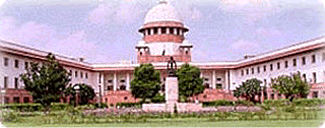
Abb.: Supreme Court of India, New Delhi
Webpräsenz: http://supremecourtofindia.nic.in/. -- Zugriff am 2004-01-02
Gegründet: 1950-01-28
Vorgänger:
Es folgt die Darstellung auf der Webseite des Supreme Court:
JURISDICTION OF THE SUPREME COURT The Supreme Court has
original,
appellate and
advisory
jurisdiction.
Its exclusive original jurisdiction extends to any dispute between the Government of India and one or more States or between the Government of India and any State or States on one side and one or more States on the other or between two or more States, if and insofar as the dispute involves any question (whether of law or of fact) on which the existence or extent of a legal right depends. In addition, Article 32 of the Constitution gives an extensive original jurisdiction to the Supreme Court in regard to enforcement of Fundamental Rights. It is empowered to issue directions, orders or writs, including writs in the nature of habeas corpus, mandamus, prohibition, quo warranto and certiorari to enforce them. The Supreme Court has been conferred with power to direct transfer of any civil or criminal case from one State High Court to another State High Court or from a Court subordinate to another State High Court. The Supreme Court, if satisfied that cases involving the same or substantially the same questions of law are pending before it and one or more High Courts or before two or more High Courts and that such questions are substantial questions of general importance, may withdraw a case or cases pending before the High Court or High Courts and dispose of all such cases itself. Under the Arbitration and Conciliation Act, 1996, International Commercial Arbitration can also be initiated in the Supreme Court.
The appellate jurisdiction of the Supreme Court can be invoked by a certificate granted by the High Court concerned under Article 132(1), 133(1) or 134 of the Constitution in respect of any judgement, decree or final order of a High Court in both civil and criminal cases, involving substantial questions of law as to the interpretation of the Constitution. Appeals also lie to the Supreme Court in civil matters if the High Court concerned certifies : (a) that the case involves a substantial question of law of general importance, and (b) that, in the opinion of the High Court, the said question needs to be decided by the Supreme Court. In criminal cases, an appeal lies to the Supreme Court if the High Court (a) has on appeal reversed an order of acquittal of an accused person and sentenced him to death or to imprisonment for life or for a period of not less than 10 years, or (b) has withdrawn for trial before itself any case from any Court subordinate to its authority and has in such trial convicted the accused and sentenced him to death or to imprisonment for life or for a period of not less than 10 years, or (c) certified that the case is a fit one for appeal to the Supreme Court. Parliament is authorised to confer on the Supreme Court any further powers to entertain and hear appeals from any judgement, final order or sentence in a criminal proceeding of a High Court.
The Supreme Court has also a very wide appellate jurisdiction over all Courts and Tribunals in India in as much as it may, in its discretion, grant special leave to appeal under Article 136 of the Constitution from any judgment, decree, determination, sentence or order in any cause or matter passed or made by any Court or Tribunal in the territory of India.
The Supreme Court has special advisory jurisdiction in matters which may specifically be referred to it by the President of India under Article 143 of the Constitution. There are provisions for reference or appeal to this Court under Article 317(1) of the Constitution, Section 257 of the Income Tax Act, 1961, Section 7(2) of the Monopolies and Restrictive Trade Practices Act, 1969, Section 130-A of the Customs Act, 1962, Section 35-H of the Central Excises and Salt Act, 1944 and Section 82C of the Gold (Control) Act, 1968. Appeals also lie to the Supreme Court under the Representation of the People Act, 1951, Monopolies and Restrictive Trade Practices Act, 1969, Advocates Act, 1961, Contempt of Courts Act, 1971, Customs Act, 1962, Central Excises and Salt Act, 1944, Enlargement of Criminal Appellate Jurisdiction Act, 1970, Trial of Offences Relating to Transactions in Securities Act, 1992, Terrorist and Disruptive Activities (Prevention) Act, 1987 and Consumer Protection Act, 1986. Election Petitions under Part III of the Presidential and Vice Presidential Elections Act, 1952 are also filed directly in the Supreme Court.
Under Articles 129 and 142 of the Constitution the Supreme Court has been vested with power to punish for contempt of Court including the power to punish for contempt of itself. In case of contempt other than the contempt referred to in Rule 2, Part-I of the Rules to Regulate Proceedings for Contempt of the Supreme Court, 1975, the Court may take action (a) Suo motu, or (b) on a petition made by Attorney General, or Solicitor General, or (c) on a petition made by any person, and in the case of a criminal contempt with the consent in writing of the Attorney General or the Solicitor General.
Under Order XL of the Supreme Court Rules the Supreme Court may review its judgment or order but no application for review is to be entertained in a civil proceeding except on the grounds mentioned in Order XLVII, Rule 1 of the Code of Civil Procedure and in a criminal proceeding except on the ground of an error apparent on the face of the record.
PUBLIC INTEREST LITIGATION
Although the proceedings in the Supreme Court arise out of the judgments or orders made by the Subordinate Courts including the High Courts, but of late the Supreme Court has started entertaining matters in which interest of the public at large is involved and the Court can be moved by any individual or group of persons either by filing a Writ Petition at the Filing Counter of the Court or by addressing a letter to Hon'ble the Chief Justice of India highlighting the question of public importance for invoking this jurisdiction. Such concept is popularly known as 'Public Interest Litigation' and several matters of public importance have become landmark cases. This concept is unique to the Supreme Court of India only and perhaps no other Court in the world has been exercising this extraordinary jurisdiction. A Writ Petition filed at the Filing Counter is dealt with like any other Writ Petition and processed as such. In case of a letter addressed to Hon'ble the Chief Justice of India the same is dealt with in accordance with the guidelines framed for the purpose.
PROVISION OF LEGAL AID
If a person belongs to the poor section of the society having annual income of less than Rs. 18,000/- or belongs to Scheduled Caste or Scheduled Tribe, a victim of natural calamity, is a woman or a child or a mentally ill or otherwise disabled person or an industrial workman, or is in custody including custody in protective home, he/she is entitled to get free legal aid from the Supreme Court Legal Aid Committee. The aid so granted by the Committee includes cost of preparation of the* matter and all applications connected therewith, in addition to providing an Advocate for preparing and arguing the case. Any person desirous of availing legal service through the Committee has to make an application to the Secretary and hand over all necessary documents concerning his case to it. The Committee after ascertaining the eligibility of the person provides necessary legal aid to him/her.
Persons belonging to middle income group i.e. with income above Rs. 18,000/- but under Rs. 1,20,000/- per annum are eligible to get legal aid from the Supreme Court Middle Income Group Society, on nominal payments.
AMICUS CURIAE
If a petition is received from the jail or in any other criminal matter if the accused is unrepresented then an Advocate is appointed as amicus curiae by the Court to defend and argue the case of the accused. In civil matters also the Court can appoint an Advocate as amicus curiae if it thinks it necessary in case of an unrepresented party; the Court can also appoint amicus curiae in any matter of general public importance or in which the interest of the public at large is involved.
HIGH COURTS The High Court stands at the head of a State's judicial administration. There are 18 High Courts in the country, three having jurisdiction over more than one State. Among the Union Territories Delhi alone has a High Court of its own. Other six Union Territories come under the jurisdiction of different State High Courts. Each High Court comprises of a Chief Justice and such other Judges as the President may, from time to time, appoint. The Chief Justice of a High Court is appointed by the President in consultation with the Chief Justice of India and the Governor of the State. The procedure for appointing puisne Judges is the same except that the Chief Justice of the High Court concerned is also consulted. They hold office until the age of 62 years and are removable in the same manner as a Judge of the Supreme Court. To be eligible for appointment as a Judge one must be a citizen of India and have held a judicial office in India for ten years or must have practised as an Adovcate of a High Court or two or more such Courts in succession for a similar period.
Each High Court has power to issue to any person within its jurisdiction directions, orders, or writs including writs which are in the nature of habeas corpus, mandamus, prohibition, quo warranto and certiorari for enforcement of Fundamental Rights and for any other purpose. This power may also be exercised by any High Court exercising jurisdiction in relation to territories within which the cause of action, wholly or in part, arises for exercise of such power, notwithstanding that the seat of such Government or authority or residence of such person is not within those territories.
Each High Court has powers of superintendence over all Courts within its jurisdiction. It can call for returns from such Courts, make and issue general rules and prescribe forms to regulate their practice and proceedings and determine the manner and form in which book entries and accounts shall be kept.
ADVOCATE GENERAL
There is an Advocate General for each State, appointed by the Governor, who holds office during the pleasure of the Governor. He must be a person qualified to be appointed as a Judge of High Court. His duty is to give advice to State Governments upon such legal matters and to perform such other duties of legal character, as may be referred or assigned to him by the Governor. The Advocate General has the right to speak and take part in the proceedings of the State Legislature without the right to vote.
[Quelle: http://supremecourtofindia.nic.in/new_s/juris.htm. -- Zugriff am 2004-01-01]
| Name | Webpräsenz | Zitiert als | Gründungsjahr | Territoriale Jurisdiktion | Sitz |
|---|---|---|---|---|---|
| Allahabad | http://allahabadhighcourt.nic.in/. -- Zugriff am 2004-01-02 | All | 1866 | Uttar Pradesh | Allahabad (Bench at Lucknow) |
| Andhra Pradesh | http://hc.ap.nic.in/. -- Zugriff am 2004-01-02 | AP | 1956 | Andhra Pradesh | Hyderabad |
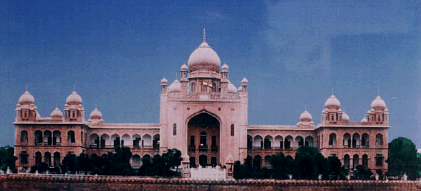 Abb.: High Court of Andhra Pradesh, Hyderabad |
|||||
| Bombay | http://hcbom.mah.nic.in/. -- Zugriff am 2004-01-02 | Bom | 1862 | Maharashtra, Goa, Dadra and Nagar Haveli and Daman and Diu | Bombay (Benches at Nagpur, Panaji and Aurangabad) |
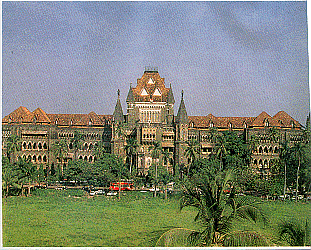 Abb.: Bombay High Court |
|||||
| Calcutta | http://causelists.nic.in/calcutta/web_cal/. -- Zugriff am 2004-01-02 | Cal | 1862 | West Bengal | Calcutta (Circuit Bench at Port Blair) |
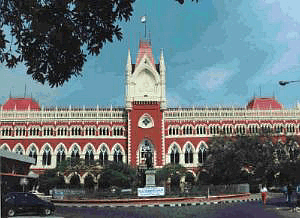 Abb.: Calcutta High Court |
|||||
| Chhattisgarh | http://cghighcourt.nic.in/. -- Zugriff am 2004-01-02 | 2000 | Chhattisgarh | Bilaspur | |
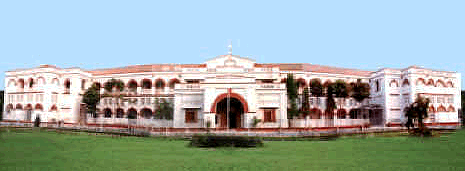 Abb.: High Court of Chhatishgarh |
|||||
| Delhi | http://delhihighcourt.nic.in/. -- Zugriff am 2004-01-02 | Del | 1966 | Delhi | Delhi |
|
Guwahati (Originally known as the Assam High Court, renamed as Guwahati High Court in 1971) |
http://www.ghconline.nic.in/. -- Zugriff am 2004-01-02 | Assam | 1948 | Assam, Manipur, Meghalaya, Nagaland,Tripura, Mizoram and Arunachal Pradesh | Guwahati (Benches at Kohima, Aizwal & Imphal. Circuit Bench at Agartala & Shillong) |
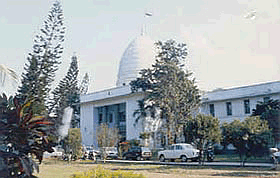 Abb.: Gauhati High Court |
|||||
| Gujarat | http://gujarathighcourt.nic.in/. -- Zugriff am 2004-01-02 | Guj | 1960 | Gujarat | Ahmedabad |
| Himachal Pradesh | http://www.himachal.nic.in/highcourt/. -- Zugriff am 2004-01-02 | HP | 1971 | Himachal Pradesh | Shimla |
| Jammu & Kashmir | http://www.jkhighcourt.nic.in/. -- Zugriff am 2004-01-02 | J&K | 1928 | Jammu & Kashmir | Srinagar & Jammu |
| Jharkhand High Court | http://www.jharkhandhighcourt.nic.in/. -- Zugriff am 2004-01-02 | 2000 | Jharkhand | Ranchi | |
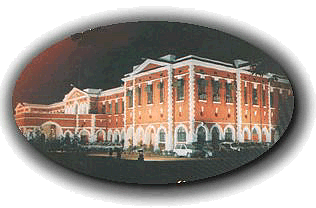 Abb.: Jharkhand High Court |
|||||
| Karnataka (Originally known as Mysore High Court, renamed as Karnataka High Court in 1973) | http://karnatakajudiciary.kar.nic.in/ -- Zugriff am 2004-01-02 | Mys Kant |
1884 | Karnataka | Bangalore |
| Kerala | http://highcourtofkerala.nic.in/. -- Zugriff am 2004-01-02 | Ker | 1958 | Kerala & Lakshadweep | Ernakulam |
| Madhya Pradesh | http://indiancourts.nic.in/maint_cause.htm. -- Zugriff am 2004-01-02 | MP | 1956 | Madhya Pradesh | Jabalpur (Benches at Gwalior and Indore) |
| Madras | http://causelists.nic.in/chennai_new/index1.html. -- Zugriff am 2004-01-02 | Mad | 1862 | Tamil Nadu & Pondicherry | Madras |
| Orissa | http://causelists.nic.in/orissa/index1.html. -- Zugriff am 2004-01-02 | Ori | 1948 | Orissa | Cuttack |
| Patna | http://causelists.nic.in/patna/index1.html. -- Zugriff am 2004-01-02 | Pat | 1916 | Bihar | Patna (Bench at Ranchi) |
|
Punjab & Haryana ( Originally known as Punjab High Court, renamed as Punjab & Haryana High Court in 1966) |
http://chd.nic.in/highcourt/. -- Zugriff am 2004-01-02 | P&H |
1975 |
Punjab, Haryana & Chandigarh |
Chandigarh |
| Rajasthan | http://causelists.nic.in/jodh/index1.html. -- Zugriff am 2004-01-02 | Raj | 1949 | Rajasthan | Jodhpur (Bench at Jaipur) |
| Sikkim | * | 1975 | 1975 |
Sikkim |
Gangtok |
States are divided into districts (zillas ), and within each a judge presides as a district judge over civil cases. A sessions judge presides over criminal cases. The judges are appointed by the governor in consultation with the state's high court. District courts are subordinate to the authority of their high court.
Die Webpräsenz der Delhi District Courts [ http://delhidistrictcourts.nic.in/. -- Zugriff am 2004-01-02] gibt einen guten Eindruck von den verschiedenen Distriktgerichtshöfen mit ihren unterschiedlichen Zuständigkeiten:
Civil Jurisdiction
Delhi is one civil district headed by the District Judge. The majority of the civil courts are situated at District Courts Complex, Tis Hazari. Courts of Civil Judges deal with matters upto the valuation of Rs.3.00 Lacs. The Courts of Additional District Judges hear matters above Rs.3.00 Lacs upto Rs.20.00 Lacs. Appeals from the judgements of the Civil Judges can be filed before the District Judge. Some of the appellate powers have also been delegated to the Senior Civil Judge, like he can hear appeals:
- in a small cause of a value not exceeding Rs.1,000/-
- in a land suit of a value not exceeding Rs.250/-
- in an unclassed suit of a value not exceeding Rs.500/-.
Criminal Jurisdiction
Matrimonial Jurisdiction
Cases under the Hindu Marriage Act relating to Divorce, Restitution of Conjugal Rights and permanent alimony etc. are tried exclusively by Matrimonial Courts. About half a dozen such Courts are functioning in Tis Hazari Complex apart from two Courts in Karkardooma Court Complex.
Labour Cases Jurisdiction
In Delhi, there are three Industrial Tribunals and 10 Labour Courts, which are situated in Karkardooma Courts Complex. These Courts are presided over by officers from Delhi Higher Judicial Service. The Labour Courts deal with all types of disputes between employers and employees under the provisions of Industrial Disputes Act and other Labour laws.
Majority of the disputes are referred to these Courts by the Government after receiving failure report from the Conciliation Officers but some of the disputes can be directly filed before the Courts by the aggrieved parties.
Motor Accident Cases Jurisdiction
Motor Accident Claims Tribunals deal with claims relating to loss of life/property and injury cases resulting from Motor Accidents. There are 11 MACT Courts in Tis Hazari apart from two Tribunals in Karkardooma Courts Complex and three in Patiala House. The Claims are to be directly filed in the concerned Tribunal. MACT Courts are presided over by Judicial Officers from Delhi Higher Judicial Service.
Juvenile Justice Board
Begger's CourtAfter the enactment of The Juvenile Justice (Care and Protection of Children) Act, 2000 Juvenile Court is substituted by Juvenile Justice Board consisting of a Metropolitan Magistrate as Principal Magistrate and two social workers, out of whom one shall be a woman. In Delhi the Juvenile Justice Board is functioning since 01.06.2003.
Mahila Courts
Cases of offences against women
Panchayati Adalats
The Delhi Panchayati Raj Act, 1954 provides for Panchayati Adalats with civil & criminal jurisdictions for petty suits and offences within the rural areas of Delhi. A Bench of five Panchas is formed by the Sarpanch for trial of cases. The offences triable by the Panchayati Adalat includes some petty offences under the Indian Penal Code, Cattle Trespass Act and Delhi gambling Act.
No Panchayati Adalat can inflict a substantial sentence of imprisonment. It can only impose a fine not exceeding Rs.100/-. Compensation to the Complainant can be provided out of the fine recovered and if the complaint is found to be frivolous, compensation can be awarded to the Accused.
Civil Matters are disposed off by the Circle Panchayat, which can try suits of certain natures of value not exceeding Rs.200/-.
Revenue Courts
Courts under Special Acts
Permanent Lok Adalats
[Quelle: http://delhidistrictcourts.nic.in/. -- Zugriff am 2004-01-02]
Über Panchayats und Panchayat courts in Bihar:
Frontline. -- Volume 18 - Issue 10, May 12 - 25, 2001 "Violent elections in Bihar
The elections to the 8,452 panchayats in Bihar, held after 23 years, are marked by high voter turnout, despite violence.
KALYAN CHAUDHURI
THE six-phase, 19-day panchayat elections held in caste-ridden Bihar in April were swathed in blood. At least 100 people were killed and thousands injured in the turf war between the old masters from the upper castes and the newly empowered Dalits. There were 1,30,563 candidates for mukhia (panchayat head), 2,28,995 for seats in the panchayat committee and over four lakhs for membership in the district councils. The elections, in 8,452 panchayats in 29 districts, were held after 23 years.
The police keep a vigil outside a polling booth in Maner.Panchayat institutions in the State suffered badly as successive State governments, wary of relinquishing power in favour of local governments, withheld funds from them and avoided conducting regular elections to them. In the 1980s, these anomalies were addressed to some extent through an amendment to the Constitution and by adopting a new and improved model of local governance. But the objectives were defeated by caste-based politics, which rather deepened social cleavages than build trust among social groups. One reason for the bloodbath that accompanied the elections was the exploitation of caste affiliations by political parties, which viewed the elections as a round of mini general elections.
The police were unable to prevent the spread of violence in spite of having taken preventive measures such as the arrest of 40,000 people with criminal records, the closure of a number of mini gun factories and the seizure of illegal arms.
This is largely attributed to the social inequality and tensions that prevail in the State. The emergence of several ultra-Left groups, such as the outlawed Communist Party of India (Marxist-Leninist), People's War and Maoist Communist Centre (MCC), has heightened tensions.
The government imposed shoot-at-sight orders, sealed the international border with Nepal and the boundary with Uttar Pradesh, Jharkhand and West Bengal, and borrowed 115,000 rifles from the neighbouring States to arm its police force and home guards in order to prevent election-related violence. Although the Centre turned down the Rabri Devi government's request for 35 companies of paramilitary forces, the State managed to deploy 50,000 policemen and 57,000 home guards for election duty. The government provided an insurance cover of Rs.10 lakhs each to its employees and policemen engaged in election work.
Poll violence and electoral irregularities in Bihar date back to the first simultaneous parliamentary and Assembly elections held in 1951-52. Since panchayat elections are not party-based, the State administration this time did not anticipate violence. It seems to have ignored the fact that 500 persons lost their lives in the 1978 panchayat elections. The 73rd amendment to the Constitution bestowed on panchayat heads increased executive and financial powers. In rural Bihar polarised on caste lines, candidates go to any extent to win the battle of ballots. Major political figures, even if they are not in the fray, try to take power by proxy by pushing members of their family into grassroots politics. Even Laloo Prasad Yadav, former Chief Minister and the ruling Rashtriya Janata Dal's (RJD) president, resorted to this practice. Shiv Prasad Chowdhury, father of Laloo Prasad's wife Rabri Devi, had contested for the post of mukhia in Salar Kalam Panchayat. The elections in Salar Kalam in Gopalgunj district were "fiercely fought". A section of the media reported that Chowdhury's younger son Subhas Yadav, a member of the State Legislative Council, was present in the panchayat with jeep-loads of supporters and security personnel, intimidating voters. In his native Phulwaria block, Laloo Prasad's younger brother and nephew contested the panchayat polls. The wife of Animal Husbandry Minister Aditya Singh contested from Nawada, while former Minister Vijay Krishna's wife contested from Mokama. The brother and nephew of the Member of Parliament from Saharsa, Dinesh Chandra Yadav, also contested the polls.
The voter turnout, at 65 per cent, was impressive given the atmosphere of violence. More notable was the response from women voters. The presence of women in large numbers reportedly turned out to be a major deterrent for booth-capturers. Even so, a 63-year-old woman died in Vaishali after she was hit by splinters from a bomb. Official sources said that 50 per cent of the total votes polled belonged to women. Most of them were exercising their franchise for the first time in panchayat polls.
This is perhaps a lateral effect of the general rise of political consciousness among the backward castes, who earlier feared to vote as the booths were controlled by armed goons employed by landlords belonging to the upper caste Bhumihar and Rajput communities.
WITH the panchayat polls over, the village residents echo a demand that is common to the countryside: Gaonka samasya gaon me neptaiye (let village's problems be settled in the village itself). The traditional village court system (gram kachari) has run into a controversy. Polls to the village courts have been withheld by the government, and a case in this connection is pending in the Supreme Court. "The village panchayat court was a strong rural tradition. It was with the birth of the new Panchayat Act that the States began to impose their own concepts. Some States withdrew all judicial powers belonging to these courts, others granted only nominal empowerment," explained Tejnarayan Singh, secretary, Bihar Raj Panchayat Parishad, an autonomous organisation conducting research on village self-rule. The village-level judicial bodies gradually became defunct. An impression was born that the sarpanch, the head of the village court, was not often impartial. "Personal feuds and class and caste relationships perhaps resulted in biases in the dispensation of justice," observes a study conducted by A.N. Sinha Institute of Social and Economic Research, Patna. From the 1980s onwards, village-level judicial set-ups began to assume different forms in different States according to the respective Panchayat Acts - village self-rule being a State subject. As per the new norm, the governments of West Bengal and Madhya Pradesh withdrew all powers vested with the traditional village head to try criminal cases. Village courts could only deal with civic disputes or act as arbitrators in property disputes.
The Bihar act did have a provision for gram kacharis. The Bihar Panchayat Raj Act in fact bestowed upon the village court the powers to award jail terms up to three months and impose fines up to Rs.1,000 (failure to pay the fine would mean a month's jail). The underlying hope was that the bulk of petty disputes would be settled at the village level itself rather than encumber the subdivisional levels of judiciary. The Act also gave the gram kacharis some more teeth, by providing for the creation of a gram raksha dal, a village volunteer force, which would virtually act as the police in the village-level administration. As per the orders of the Patna High Court, the appointment of the Sarpanch has to be based on a minimum educational qualification; this is to ensure the Sarpanch can handle tricky cases. The State government, as well as several social organisations have petitioned against the court order on the plea that the high rate of illiteracy in rural Bihar would render the choice of a literate man for the job difficult.
With the panchayats to be formed shortly, village-level panchayat members will not adorn their seats, as elections to the posts of Sarpanch have been withheld. So the people's demand for the settlement of all disputes at the village-level will not be met until the dispute is finally settled in the Supreme Court. "
[Quelle: http://www.frontlineonnet.com/fl1810/18100380.htm. -- Zugriff am 2004-01-02]
Panchayat in action:
"Panchayat's justice: Humiliate, punish and ostracise For 20-year-old Prem, the year 2002 was a nightmare she will never forget. And going by the social forces ranged against her, she doesn't see much hope in the new year either.
Prem's crime is that she tried to challenge the obscurantist social order. She was married to a man who was impotent. Early last year she picked up courage and told her parents that she wanted to leave him. The village panchayat stepped in, and decided to put her through a bizarre and humiliating test: she and her husband Chunna Ram were locked in a room and ordered to have sex. After four hours the husband emerged from the room and is believed to have confessed to the panchayat standing outside, "I'm not wothy of this girl."
That wasn't the end of the story. Shortly after she married another man, an angry panchayat stepped in again; they levied a fine of Rs. one lakh each on Prem's father Nathu Ram and her new in-laws. Since neither family can afford to pay this amount, they are now living as outcasts."
What I had to undergo was humiliating enough but now we are having to face daily torture," says a desolate prem as she sits in her bare mudhut in Sarunda village, deep in the scrublands surrounding bikaner."
I suggested to the panchayat that the boy be asked to undergo a medical examination," says a Kesu, Prem's mother, who lives in nearby Guda village. "But they refused to listen. They treated my daughter even worse than an animal." Nathu Ram, Prem's father, says he had no say in this matter as he was completely isolated in the panchayat.
With the social sanctions in place, Prem cannot visit her parents in the nearby village, nobody is willing to employ her father, her youngest sister has dropped out of school as she is constantly teased by her classmates while her mother can fill water at the community tap only after the other villagers have left.
With this matter now being probed by the women and child department at Bikaner following a complaint by Nathu Ram, the villagers have clammed up. Shankar Lodh, who was deputed to represent Guda village at the Jat panchayat, looks visibly nervous when questioned about this case. He admits that there was a public trial but adds hastily that no force was used. "The girl's parents agreed with the decision," he explains, saying he did object to the panchayat's decision but was in a minority. "What can I do? After all I have to live in this community," he says apologetically.
But panchayat head Sohan Ram Kheleri denies the whole episode. There was no question of asking anybody to go through such a trial, he says and adds the couple was asked to meet at a neutral place to allow them to sort out their differences as the panchayat was trying to see if the marriage could be saved. "When the girl insisted that she did not want to stay with him, we agreed with her decision," he contends, denying that Nathu Ram had been fined or ostracised.
According to Priyanka Goswami, deputy director, women and child department, these denials do not sound convincing. It is not possible to make up a story like this. Prem's first husband admitted to it first but subsequently brought a medical certificate from a doctor in Ahmedabad, saying he is fit.Goswami, however, points out that Prem's father filed a complaint only after he was asked to pay the penalty by the panchayat. "The emphasis of his complaint is on the penalty and the social sanctions imposed on him and not the incident," Goswami adds."
[Quelle: http://www.reportingpeople.org/issues_panchstory13.htm. -- Zugriff am 2004-01-02]
LOK ADALATS Lok Adalats which are voluntary agencies are monitored by the State Legal Aid and Advice Boards. They have proved to be a successful alternative forum for resolving of disputes through the conciliatory method.
The Legal Services Authorities Act, 1987 provides statutory status to the legal aid movement and it also provides for setting up of Legal Services Authorities at the Central, State and District levels. These authorities will have their own funds. Further, Lok Adalats which are at present informal agencies will acquire statutory status. Every award of Lok Adalats shall be deemed to be a decree of a civil court or order of a Tribunal and shall be final and binding on the parties to the dispute. It also provides that in respect of cases decided at a Lok Adalat, the court fee paid by the parties will be refunded.
[Quelle: http://supremecourtofindia.nic.in/new_s/juris.htm. -- Zugriff am 2004-01-01]
Zurück zu Kapitel 9,1: Erbrecht, Allgemeines